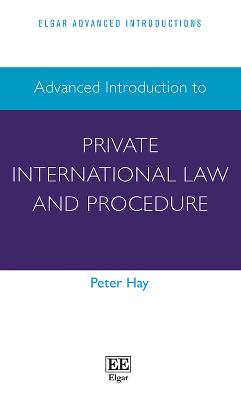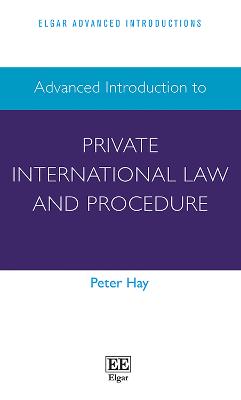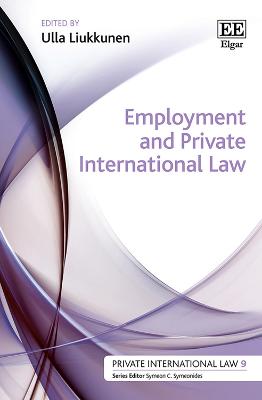Advanced Introduction to Private International Law and Procedure
Advanced Introduction to Private International Law and Procedure
Hay, Peter
Edward Elgar Publishing Ltd
06/2018
160
Mole
Inglês
9781786436801
Descrição não disponível.
Contents:
Preface
I. Introduction: Basic Issues
1.1 "Private International Law"
1.2 The Elements of an "International Civil Case"
1.2.1 Sources
1.2.2 Issues of an International Case: Where to Litigate? What Law Applies?
1.2.3 Scope of Coverage
1.2.4 A Note on Terminology: The Different Meanings of "Jurisdiction"
1.3 Applicable Law And The Goals Of Conflicts Law
1.3.1 In General
1.3.2 Historical Notes
1.3.3 The Older European Model - Rule Orientation to Achieve "Conflicts Justice"
1.3.4 The American Conflicts "Revolution"
1.3.4.1 Excursus: The American Parallel Court System
1.3.5 Modern Approaches and Trend
1.3.5.1 United States
1.3.5.2 Europe
1.3.5.3 Elsewhere
1.4 Connecting Factors
PART I JUSIRDICTION TO ADJUDICATE
II. Forum-Selection Clauses
2.1Prorogation and Derogation
2.2 Some Limits
2.2.1 European Union Law
2.2.2 The Hague Convention
2.2.3 United States
2.2.4 Rejecting a Choice
2.2.5 The Law Applicable to a Forum-Selection Clause
2.3 One-sided Clauses
2.3.1 Adhesion Provisions
2.3.2 Clauses Excluding Recourse to Court
III. Jurisdiction Over Persons and Things
3.1 In Rem Jurisdiction
3.2 General Personal Jurisdiction
3.2.1 Exorbitant Rules
3.2.2 Jurisdiction Over Companies
3.3 Specific (or Special) Jurisdiction
3.3.1 What Contacts Confer Specific Jurisdiction?
3.3.2 "Stream-of-commerce" Jurisdiction
3.3.3 Weaker Party Protection in Contract in the EU
3.3.4 Weaker Party Protection in U.S. Law
3.4 Class Actions
3.5 Piercing the Corporate Veil for Jurisdiction
3.6 Jurisdiction in Domestic Relations Cases
3.6.1 Introduction
3.6.2 Marriage
3.6.3 Divorce
3.6.4 Child Custody
3.6.5 Maintenance, Child Support, and the like
3.6.6 Adoption
3.7 Dismissal for Lis Pendens or Forum Non Conveniens
3.7.1 Lis Alibi Pendens
3.7.2 Forum non conveniens
3.7.2.1 Blocking Statutes
3.8 Jurisdiction over Things - Actions in rem
3.9 Notice and Service
3.10 Taking Evidence Abroad
PART TWO: THE APPLICABLE LAW (CHOICE OF LAW)
IV. What Law Applies
4.1 Sources
4.1.1 Conventions
4.1.2 Federal-like (supranational) law: The Example of the European Union.
4.1.3 National (Domestic) Law: In General
4.2 Party Autonomy
4.2.1 Scope, Limits, Validity
4.2.2 Unusual Cases: Partial Choice of Law; "Floating Clauses"
4.3 How to Determine the Applicable Law in the Absence of a Party Choice: By Rule or Case-Specific Approach? - The Examples of Tort and Contract Conflicts Law
4.3.1 Civil Law
4.3.1.1. Example: European Union Conflicts Law in Tort and Contract
4.3.1.1.1 Contracts: Rome I
4.3.1.1.2 Torts and Other Non-Contractual Relationships: Rome II
4.3.2 Rule Orientation in the Common Law
4.3.2.1 Escape
4.3.3 The American "Conflicts Revolution" and Case-Specific Approaches
4.3.3.1 "Governmental Interest Analysis"
4.3.3.2 Better Law
4.3.3.3 The "Most Significant Relationship:" The Second Restatement
4.3.3.4 What Is American Conflicts Law Today, Especially in Tort and Contract?
4.3.4 Applicable Law for the Whole or only Part of the Case?
4.3.4.1 Characterization
4.3.4.2 Splitting a Case Into Its Component Issues: Depecage
4.3.5 Connecting Factors, Especially "Domicile" and "Habitual Residence"
4.3.5.1 Domicile
4.3.5.2 Habitual Residence
4.4 Renvoi
4.5 Special Aspects in American Law Regarding Time Limits; Damages
4.5.1 Time Limitations
4.5.2 Damages
4.6 Choice of Law in Other Areas Than Tort or Contract
4.6.1 Family Law
4.6.1.1 Capacity
4.6.1.2 Forms of Marriage
4.6.1.3 Marital Property
4.6.1.4 Support
4.6.2 Succession
4.6.2.1 Introduction
4.6.2.2 Procedural Issues
4.6.2.3 Applicable Law
4.6.2.4 European Union Law
4.6.2.5 Recognition
4.6.3 Corporate Entities
4.7 Forum Policy: Mandatory Norms and the Public Policy Exception
4.8 How to Determine the Content of Applicable Foreign Law?
4.8.1 How Does Foreign Law Become Applicable?
4.8.2 Determining the Content of and Applying Foreign Law
PART THREE: JUDGMENTS
V. Recognition and Enforcement of Foreign Jugments
5.1 Introduction
5.2 The Nature of the Foreign Decree
5.2.1 Finality
5.2.2 The Issuing Authority
5.2.3 Effect in Another State
5.3 Methods of Recognition - International Solutions
5.3.1 Treaties
5.3.2 Reciprocal Recognition Arrangements
5.3.3 The European Union's "federal-type" Approach
5.3.4 The Lugano Convention
5.4 Recognition - National Law Approaches
5.4.1 The Civil Law Exequatur
5.4.2 Recognition Under Common Law
5.4.2.1 Recognition Within the United States
5.5 Defenses to Recognition and Enforcement
5.5.1 In General
5.5.2 Lack of Jurisdiction
5.5.2.1 Unified Systems - The United States and the EU
5.5.2.2 Testing Another Country's Jurisdiction Under National Law
5.5.3 Notice
5.5.4 Conflicting Judgments
5.5.5 Public Policy
5.5.5.1 In General
5.5.5.2 Public Policy and revision au fond
5.5.5.3 Public Policy and Exporting Forum Values
5.5.6 No Remedy Available Locally
5.6 The Effect of a Recognized Judgment
5.6.1 The Res Judicata Effect on the Parties
5.6.2 Effect on Third Parties
5.7 Enforcement Mechanisms
5.7.1 Foreign-Country Judgments in the United States
5.7.2 Recognition Elsewhere
VI. An Assessment: Tasks, Developments, Trends
6.1 In General
6.2 Jurisdiction and Judgment Recognition of Civil and Commercial Judgments
6.2.1 Worldwide Harmonization
6.2.2 Regional Harmonization
6.2.3 National Law
6.3 Choice of Law
Appendix
Sources of European Union Law
Index
Preface
I. Introduction: Basic Issues
1.1 "Private International Law"
1.2 The Elements of an "International Civil Case"
1.2.1 Sources
1.2.2 Issues of an International Case: Where to Litigate? What Law Applies?
1.2.3 Scope of Coverage
1.2.4 A Note on Terminology: The Different Meanings of "Jurisdiction"
1.3 Applicable Law And The Goals Of Conflicts Law
1.3.1 In General
1.3.2 Historical Notes
1.3.3 The Older European Model - Rule Orientation to Achieve "Conflicts Justice"
1.3.4 The American Conflicts "Revolution"
1.3.4.1 Excursus: The American Parallel Court System
1.3.5 Modern Approaches and Trend
1.3.5.1 United States
1.3.5.2 Europe
1.3.5.3 Elsewhere
1.4 Connecting Factors
PART I JUSIRDICTION TO ADJUDICATE
II. Forum-Selection Clauses
2.1Prorogation and Derogation
2.2 Some Limits
2.2.1 European Union Law
2.2.2 The Hague Convention
2.2.3 United States
2.2.4 Rejecting a Choice
2.2.5 The Law Applicable to a Forum-Selection Clause
2.3 One-sided Clauses
2.3.1 Adhesion Provisions
2.3.2 Clauses Excluding Recourse to Court
III. Jurisdiction Over Persons and Things
3.1 In Rem Jurisdiction
3.2 General Personal Jurisdiction
3.2.1 Exorbitant Rules
3.2.2 Jurisdiction Over Companies
3.3 Specific (or Special) Jurisdiction
3.3.1 What Contacts Confer Specific Jurisdiction?
3.3.2 "Stream-of-commerce" Jurisdiction
3.3.3 Weaker Party Protection in Contract in the EU
3.3.4 Weaker Party Protection in U.S. Law
3.4 Class Actions
3.5 Piercing the Corporate Veil for Jurisdiction
3.6 Jurisdiction in Domestic Relations Cases
3.6.1 Introduction
3.6.2 Marriage
3.6.3 Divorce
3.6.4 Child Custody
3.6.5 Maintenance, Child Support, and the like
3.6.6 Adoption
3.7 Dismissal for Lis Pendens or Forum Non Conveniens
3.7.1 Lis Alibi Pendens
3.7.2 Forum non conveniens
3.7.2.1 Blocking Statutes
3.8 Jurisdiction over Things - Actions in rem
3.9 Notice and Service
3.10 Taking Evidence Abroad
PART TWO: THE APPLICABLE LAW (CHOICE OF LAW)
IV. What Law Applies
4.1 Sources
4.1.1 Conventions
4.1.2 Federal-like (supranational) law: The Example of the European Union.
4.1.3 National (Domestic) Law: In General
4.2 Party Autonomy
4.2.1 Scope, Limits, Validity
4.2.2 Unusual Cases: Partial Choice of Law; "Floating Clauses"
4.3 How to Determine the Applicable Law in the Absence of a Party Choice: By Rule or Case-Specific Approach? - The Examples of Tort and Contract Conflicts Law
4.3.1 Civil Law
4.3.1.1. Example: European Union Conflicts Law in Tort and Contract
4.3.1.1.1 Contracts: Rome I
4.3.1.1.2 Torts and Other Non-Contractual Relationships: Rome II
4.3.2 Rule Orientation in the Common Law
4.3.2.1 Escape
4.3.3 The American "Conflicts Revolution" and Case-Specific Approaches
4.3.3.1 "Governmental Interest Analysis"
4.3.3.2 Better Law
4.3.3.3 The "Most Significant Relationship:" The Second Restatement
4.3.3.4 What Is American Conflicts Law Today, Especially in Tort and Contract?
4.3.4 Applicable Law for the Whole or only Part of the Case?
4.3.4.1 Characterization
4.3.4.2 Splitting a Case Into Its Component Issues: Depecage
4.3.5 Connecting Factors, Especially "Domicile" and "Habitual Residence"
4.3.5.1 Domicile
4.3.5.2 Habitual Residence
4.4 Renvoi
4.5 Special Aspects in American Law Regarding Time Limits; Damages
4.5.1 Time Limitations
4.5.2 Damages
4.6 Choice of Law in Other Areas Than Tort or Contract
4.6.1 Family Law
4.6.1.1 Capacity
4.6.1.2 Forms of Marriage
4.6.1.3 Marital Property
4.6.1.4 Support
4.6.2 Succession
4.6.2.1 Introduction
4.6.2.2 Procedural Issues
4.6.2.3 Applicable Law
4.6.2.4 European Union Law
4.6.2.5 Recognition
4.6.3 Corporate Entities
4.7 Forum Policy: Mandatory Norms and the Public Policy Exception
4.8 How to Determine the Content of Applicable Foreign Law?
4.8.1 How Does Foreign Law Become Applicable?
4.8.2 Determining the Content of and Applying Foreign Law
PART THREE: JUDGMENTS
V. Recognition and Enforcement of Foreign Jugments
5.1 Introduction
5.2 The Nature of the Foreign Decree
5.2.1 Finality
5.2.2 The Issuing Authority
5.2.3 Effect in Another State
5.3 Methods of Recognition - International Solutions
5.3.1 Treaties
5.3.2 Reciprocal Recognition Arrangements
5.3.3 The European Union's "federal-type" Approach
5.3.4 The Lugano Convention
5.4 Recognition - National Law Approaches
5.4.1 The Civil Law Exequatur
5.4.2 Recognition Under Common Law
5.4.2.1 Recognition Within the United States
5.5 Defenses to Recognition and Enforcement
5.5.1 In General
5.5.2 Lack of Jurisdiction
5.5.2.1 Unified Systems - The United States and the EU
5.5.2.2 Testing Another Country's Jurisdiction Under National Law
5.5.3 Notice
5.5.4 Conflicting Judgments
5.5.5 Public Policy
5.5.5.1 In General
5.5.5.2 Public Policy and revision au fond
5.5.5.3 Public Policy and Exporting Forum Values
5.5.6 No Remedy Available Locally
5.6 The Effect of a Recognized Judgment
5.6.1 The Res Judicata Effect on the Parties
5.6.2 Effect on Third Parties
5.7 Enforcement Mechanisms
5.7.1 Foreign-Country Judgments in the United States
5.7.2 Recognition Elsewhere
VI. An Assessment: Tasks, Developments, Trends
6.1 In General
6.2 Jurisdiction and Judgment Recognition of Civil and Commercial Judgments
6.2.1 Worldwide Harmonization
6.2.2 Regional Harmonization
6.2.3 National Law
6.3 Choice of Law
Appendix
Sources of European Union Law
Index
Este título pertence ao(s) assunto(s) indicados(s). Para ver outros títulos clique no assunto desejado.
private international law textbook; Private International Law; Conflict of Laws; Comparative; Civil and Commercial Litigation; International Civil Procedure; choice of law
Contents:
Preface
I. Introduction: Basic Issues
1.1 "Private International Law"
1.2 The Elements of an "International Civil Case"
1.2.1 Sources
1.2.2 Issues of an International Case: Where to Litigate? What Law Applies?
1.2.3 Scope of Coverage
1.2.4 A Note on Terminology: The Different Meanings of "Jurisdiction"
1.3 Applicable Law And The Goals Of Conflicts Law
1.3.1 In General
1.3.2 Historical Notes
1.3.3 The Older European Model - Rule Orientation to Achieve "Conflicts Justice"
1.3.4 The American Conflicts "Revolution"
1.3.4.1 Excursus: The American Parallel Court System
1.3.5 Modern Approaches and Trend
1.3.5.1 United States
1.3.5.2 Europe
1.3.5.3 Elsewhere
1.4 Connecting Factors
PART I JUSIRDICTION TO ADJUDICATE
II. Forum-Selection Clauses
2.1Prorogation and Derogation
2.2 Some Limits
2.2.1 European Union Law
2.2.2 The Hague Convention
2.2.3 United States
2.2.4 Rejecting a Choice
2.2.5 The Law Applicable to a Forum-Selection Clause
2.3 One-sided Clauses
2.3.1 Adhesion Provisions
2.3.2 Clauses Excluding Recourse to Court
III. Jurisdiction Over Persons and Things
3.1 In Rem Jurisdiction
3.2 General Personal Jurisdiction
3.2.1 Exorbitant Rules
3.2.2 Jurisdiction Over Companies
3.3 Specific (or Special) Jurisdiction
3.3.1 What Contacts Confer Specific Jurisdiction?
3.3.2 "Stream-of-commerce" Jurisdiction
3.3.3 Weaker Party Protection in Contract in the EU
3.3.4 Weaker Party Protection in U.S. Law
3.4 Class Actions
3.5 Piercing the Corporate Veil for Jurisdiction
3.6 Jurisdiction in Domestic Relations Cases
3.6.1 Introduction
3.6.2 Marriage
3.6.3 Divorce
3.6.4 Child Custody
3.6.5 Maintenance, Child Support, and the like
3.6.6 Adoption
3.7 Dismissal for Lis Pendens or Forum Non Conveniens
3.7.1 Lis Alibi Pendens
3.7.2 Forum non conveniens
3.7.2.1 Blocking Statutes
3.8 Jurisdiction over Things - Actions in rem
3.9 Notice and Service
3.10 Taking Evidence Abroad
PART TWO: THE APPLICABLE LAW (CHOICE OF LAW)
IV. What Law Applies
4.1 Sources
4.1.1 Conventions
4.1.2 Federal-like (supranational) law: The Example of the European Union.
4.1.3 National (Domestic) Law: In General
4.2 Party Autonomy
4.2.1 Scope, Limits, Validity
4.2.2 Unusual Cases: Partial Choice of Law; "Floating Clauses"
4.3 How to Determine the Applicable Law in the Absence of a Party Choice: By Rule or Case-Specific Approach? - The Examples of Tort and Contract Conflicts Law
4.3.1 Civil Law
4.3.1.1. Example: European Union Conflicts Law in Tort and Contract
4.3.1.1.1 Contracts: Rome I
4.3.1.1.2 Torts and Other Non-Contractual Relationships: Rome II
4.3.2 Rule Orientation in the Common Law
4.3.2.1 Escape
4.3.3 The American "Conflicts Revolution" and Case-Specific Approaches
4.3.3.1 "Governmental Interest Analysis"
4.3.3.2 Better Law
4.3.3.3 The "Most Significant Relationship:" The Second Restatement
4.3.3.4 What Is American Conflicts Law Today, Especially in Tort and Contract?
4.3.4 Applicable Law for the Whole or only Part of the Case?
4.3.4.1 Characterization
4.3.4.2 Splitting a Case Into Its Component Issues: Depecage
4.3.5 Connecting Factors, Especially "Domicile" and "Habitual Residence"
4.3.5.1 Domicile
4.3.5.2 Habitual Residence
4.4 Renvoi
4.5 Special Aspects in American Law Regarding Time Limits; Damages
4.5.1 Time Limitations
4.5.2 Damages
4.6 Choice of Law in Other Areas Than Tort or Contract
4.6.1 Family Law
4.6.1.1 Capacity
4.6.1.2 Forms of Marriage
4.6.1.3 Marital Property
4.6.1.4 Support
4.6.2 Succession
4.6.2.1 Introduction
4.6.2.2 Procedural Issues
4.6.2.3 Applicable Law
4.6.2.4 European Union Law
4.6.2.5 Recognition
4.6.3 Corporate Entities
4.7 Forum Policy: Mandatory Norms and the Public Policy Exception
4.8 How to Determine the Content of Applicable Foreign Law?
4.8.1 How Does Foreign Law Become Applicable?
4.8.2 Determining the Content of and Applying Foreign Law
PART THREE: JUDGMENTS
V. Recognition and Enforcement of Foreign Jugments
5.1 Introduction
5.2 The Nature of the Foreign Decree
5.2.1 Finality
5.2.2 The Issuing Authority
5.2.3 Effect in Another State
5.3 Methods of Recognition - International Solutions
5.3.1 Treaties
5.3.2 Reciprocal Recognition Arrangements
5.3.3 The European Union's "federal-type" Approach
5.3.4 The Lugano Convention
5.4 Recognition - National Law Approaches
5.4.1 The Civil Law Exequatur
5.4.2 Recognition Under Common Law
5.4.2.1 Recognition Within the United States
5.5 Defenses to Recognition and Enforcement
5.5.1 In General
5.5.2 Lack of Jurisdiction
5.5.2.1 Unified Systems - The United States and the EU
5.5.2.2 Testing Another Country's Jurisdiction Under National Law
5.5.3 Notice
5.5.4 Conflicting Judgments
5.5.5 Public Policy
5.5.5.1 In General
5.5.5.2 Public Policy and revision au fond
5.5.5.3 Public Policy and Exporting Forum Values
5.5.6 No Remedy Available Locally
5.6 The Effect of a Recognized Judgment
5.6.1 The Res Judicata Effect on the Parties
5.6.2 Effect on Third Parties
5.7 Enforcement Mechanisms
5.7.1 Foreign-Country Judgments in the United States
5.7.2 Recognition Elsewhere
VI. An Assessment: Tasks, Developments, Trends
6.1 In General
6.2 Jurisdiction and Judgment Recognition of Civil and Commercial Judgments
6.2.1 Worldwide Harmonization
6.2.2 Regional Harmonization
6.2.3 National Law
6.3 Choice of Law
Appendix
Sources of European Union Law
Index
Preface
I. Introduction: Basic Issues
1.1 "Private International Law"
1.2 The Elements of an "International Civil Case"
1.2.1 Sources
1.2.2 Issues of an International Case: Where to Litigate? What Law Applies?
1.2.3 Scope of Coverage
1.2.4 A Note on Terminology: The Different Meanings of "Jurisdiction"
1.3 Applicable Law And The Goals Of Conflicts Law
1.3.1 In General
1.3.2 Historical Notes
1.3.3 The Older European Model - Rule Orientation to Achieve "Conflicts Justice"
1.3.4 The American Conflicts "Revolution"
1.3.4.1 Excursus: The American Parallel Court System
1.3.5 Modern Approaches and Trend
1.3.5.1 United States
1.3.5.2 Europe
1.3.5.3 Elsewhere
1.4 Connecting Factors
PART I JUSIRDICTION TO ADJUDICATE
II. Forum-Selection Clauses
2.1Prorogation and Derogation
2.2 Some Limits
2.2.1 European Union Law
2.2.2 The Hague Convention
2.2.3 United States
2.2.4 Rejecting a Choice
2.2.5 The Law Applicable to a Forum-Selection Clause
2.3 One-sided Clauses
2.3.1 Adhesion Provisions
2.3.2 Clauses Excluding Recourse to Court
III. Jurisdiction Over Persons and Things
3.1 In Rem Jurisdiction
3.2 General Personal Jurisdiction
3.2.1 Exorbitant Rules
3.2.2 Jurisdiction Over Companies
3.3 Specific (or Special) Jurisdiction
3.3.1 What Contacts Confer Specific Jurisdiction?
3.3.2 "Stream-of-commerce" Jurisdiction
3.3.3 Weaker Party Protection in Contract in the EU
3.3.4 Weaker Party Protection in U.S. Law
3.4 Class Actions
3.5 Piercing the Corporate Veil for Jurisdiction
3.6 Jurisdiction in Domestic Relations Cases
3.6.1 Introduction
3.6.2 Marriage
3.6.3 Divorce
3.6.4 Child Custody
3.6.5 Maintenance, Child Support, and the like
3.6.6 Adoption
3.7 Dismissal for Lis Pendens or Forum Non Conveniens
3.7.1 Lis Alibi Pendens
3.7.2 Forum non conveniens
3.7.2.1 Blocking Statutes
3.8 Jurisdiction over Things - Actions in rem
3.9 Notice and Service
3.10 Taking Evidence Abroad
PART TWO: THE APPLICABLE LAW (CHOICE OF LAW)
IV. What Law Applies
4.1 Sources
4.1.1 Conventions
4.1.2 Federal-like (supranational) law: The Example of the European Union.
4.1.3 National (Domestic) Law: In General
4.2 Party Autonomy
4.2.1 Scope, Limits, Validity
4.2.2 Unusual Cases: Partial Choice of Law; "Floating Clauses"
4.3 How to Determine the Applicable Law in the Absence of a Party Choice: By Rule or Case-Specific Approach? - The Examples of Tort and Contract Conflicts Law
4.3.1 Civil Law
4.3.1.1. Example: European Union Conflicts Law in Tort and Contract
4.3.1.1.1 Contracts: Rome I
4.3.1.1.2 Torts and Other Non-Contractual Relationships: Rome II
4.3.2 Rule Orientation in the Common Law
4.3.2.1 Escape
4.3.3 The American "Conflicts Revolution" and Case-Specific Approaches
4.3.3.1 "Governmental Interest Analysis"
4.3.3.2 Better Law
4.3.3.3 The "Most Significant Relationship:" The Second Restatement
4.3.3.4 What Is American Conflicts Law Today, Especially in Tort and Contract?
4.3.4 Applicable Law for the Whole or only Part of the Case?
4.3.4.1 Characterization
4.3.4.2 Splitting a Case Into Its Component Issues: Depecage
4.3.5 Connecting Factors, Especially "Domicile" and "Habitual Residence"
4.3.5.1 Domicile
4.3.5.2 Habitual Residence
4.4 Renvoi
4.5 Special Aspects in American Law Regarding Time Limits; Damages
4.5.1 Time Limitations
4.5.2 Damages
4.6 Choice of Law in Other Areas Than Tort or Contract
4.6.1 Family Law
4.6.1.1 Capacity
4.6.1.2 Forms of Marriage
4.6.1.3 Marital Property
4.6.1.4 Support
4.6.2 Succession
4.6.2.1 Introduction
4.6.2.2 Procedural Issues
4.6.2.3 Applicable Law
4.6.2.4 European Union Law
4.6.2.5 Recognition
4.6.3 Corporate Entities
4.7 Forum Policy: Mandatory Norms and the Public Policy Exception
4.8 How to Determine the Content of Applicable Foreign Law?
4.8.1 How Does Foreign Law Become Applicable?
4.8.2 Determining the Content of and Applying Foreign Law
PART THREE: JUDGMENTS
V. Recognition and Enforcement of Foreign Jugments
5.1 Introduction
5.2 The Nature of the Foreign Decree
5.2.1 Finality
5.2.2 The Issuing Authority
5.2.3 Effect in Another State
5.3 Methods of Recognition - International Solutions
5.3.1 Treaties
5.3.2 Reciprocal Recognition Arrangements
5.3.3 The European Union's "federal-type" Approach
5.3.4 The Lugano Convention
5.4 Recognition - National Law Approaches
5.4.1 The Civil Law Exequatur
5.4.2 Recognition Under Common Law
5.4.2.1 Recognition Within the United States
5.5 Defenses to Recognition and Enforcement
5.5.1 In General
5.5.2 Lack of Jurisdiction
5.5.2.1 Unified Systems - The United States and the EU
5.5.2.2 Testing Another Country's Jurisdiction Under National Law
5.5.3 Notice
5.5.4 Conflicting Judgments
5.5.5 Public Policy
5.5.5.1 In General
5.5.5.2 Public Policy and revision au fond
5.5.5.3 Public Policy and Exporting Forum Values
5.5.6 No Remedy Available Locally
5.6 The Effect of a Recognized Judgment
5.6.1 The Res Judicata Effect on the Parties
5.6.2 Effect on Third Parties
5.7 Enforcement Mechanisms
5.7.1 Foreign-Country Judgments in the United States
5.7.2 Recognition Elsewhere
VI. An Assessment: Tasks, Developments, Trends
6.1 In General
6.2 Jurisdiction and Judgment Recognition of Civil and Commercial Judgments
6.2.1 Worldwide Harmonization
6.2.2 Regional Harmonization
6.2.3 National Law
6.3 Choice of Law
Appendix
Sources of European Union Law
Index
Este título pertence ao(s) assunto(s) indicados(s). Para ver outros títulos clique no assunto desejado.






